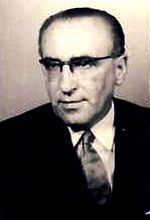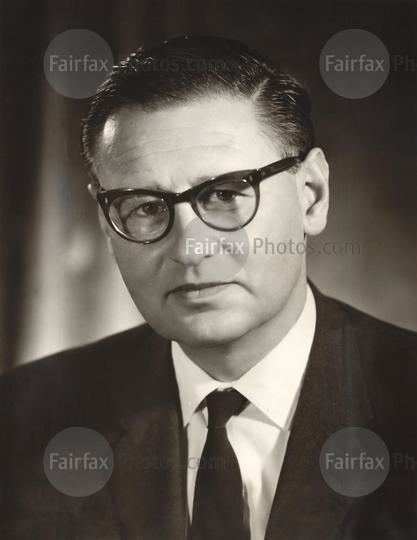Nationality German Occupation Architect | Name Frederick Romberg Role Architect | |
 | ||
Born 21 June 1913 Tsingtao, China Awards Inaugural President’s prize, National Architecture 2006 - National 25 Year Award Practice Grounds Romberg and Boyd (Gromboyd), later Romberg and Boyd Buildings Stanhill Flats, Newburn Flats, ETA Foods Factory, MacFarland Library, Ormond College, ICI Staff Recreation Centre, Holy Trinity Lutheran Church Books The Decline of the Environment | ||
The frederick romberg award for residential architecture multiple housing
Frederick Romberg, (Friedrich Sigismund Hermann Romberg), (21 June 1913, in Tsingtao – 12 November 1992, in Melbourne), was a Swiss-trained architect who migrated to Australia in 1938.
Contents
- The frederick romberg award for residential architecture multiple housing
- Adelaide boys high school by frederick romberg
- Early life and education
- Migration and early practice
- Grounds Romberg and Boyd 1953 1962
- Architecture style The Central Plan
- Architecture style Brutalism
- The breakup of the partnership Romberg and Boyd 1962 1975
- University of Newcastle NSW
- Return to Melbourne
- Stanhill Flats
- Newburn Flats
- Picken Court Ormond College
- ETA Foods Factory
- Other works
- Awards
- References

Romberg was known as the "middle term" in the architectural partnership of Grounds, Romberg and Boyd (Gromboyd) formed in Melbourne 1953 and dissolved in 1962. Ascribed his Swiss education as well as his awareness of great European academic tradition, he brought in the heritage of Switzerland and Germany to be re-formed into architecture appropriate to Australia with an intellectual preparation of design and execution. He led the way in exploring empiricist reinterpretation of modernism in the 1940s, His buildings are characteristically empiricist in intention and form, using local materials within the formal framework of modernism. In the 1950s, his buildings adopted forms of Australian rural architecture, and, beginning in 1983, gradually became well known in outskirt suburb areas of Melbourne’s architectural community.

Adelaide boys high school by frederick romberg
Early life and education

Frederick Romberg, second child of Prussian parents Kurt and Else Romberg, was born on 21 June 1913 in Tsingtao, China with German origin. When he was born, his father worked in the Colonial Office in Tsingtao who was once a doctor of law and a judge in Berlin. He was later returned to Berlin with his parents in September 1913. About 7 years old, he was sent to stay for a year with his maternal grandparents in central Berlin and attended the Stresemann Real-Gymnasium, where the principal Walter Schadow, a supporter of Weimar Republic which has a broad vision of world affairs and Western cultural heritage. After his first enrolment in law at the University of Geneva, he later enrolled and spent five years between 1933-38 in an architecture course at the Swiss Federal Institute of Technology (ETH-Zurich), one of the world’s leading technical universities. The earlier semesters of the course had a strong component of technical subjects such as mathematics, geometry and building statics. He developed a remarkably consistent and rigorous language of architectural form by handling with its ideology of modern movement, ribbon windows, cantilevers, roof gardens, open plan and new urban typologies. After the graduation from the ETH-Zurich, he joined Otto Rudolf Salvisberg’s office as an architectural assistant for 6 months and on one project, the seven storey laboratory building in Basle. Later in 1938, he arrived in Melbourne and became a registered architect in 1940. In his professional career from the 1940s to 1950s, he gradually refined his European modernist education into an appropriate local architecture design.
Migration and early practice
To understand the experience of migration is of fundamental importance in understanding the architecture of Fredrick Romberg. While his commitment to Australia was absolute from the moment he arrived there, he brought with him memories, knowledge and attitudes that were European in general and German in particular. Arriving in Melbourne at Station Pier, he had an initial, brief visit to Canberra and Sydney, returned to Melbourne, and was immediately engaged by the office of Stephenson and Turner. He was seconded to the design section and worked there for a year.
Grounds, Romberg and Boyd: 1953-1962
In 1951 Romberg’s practice was in a precarious position. He had moved his office from La Trobe Street in 1949 to the front flat on the top floor of Newburn and the following year into a penthouse created from the roof garden. With his partners Roy Grounds and Robin Boyd, Romberg continued to explore local idioms in his schools, colleges and churches and to link his work to historical precedent in Australia. At the same time, he excavated his own past, resurrecting its latent classicism in order to affirm Australia’s earliest, and particularly Palladian, traditions.
Architecture style: The Central Plan
Romberg’s complex and varied approach to the central plan suggests a secure grounding in historical precedent (a subject he taught at RMIT in the late 1940s) and possibly some knowledge of the immensely influential text by Rudolf Wittkower, Architectural Principles in the Age of Humanism, first published in 1949 which dealt with both Palladian geometry and the central plan.
Architecture style: Brutalism
The relationship of Romberg’s work to be emerging Brutalist movement in England is one of the more intriguing aspects of his practice during the 1950s and early 1960s. Brutalism in Australia is generally understood as a style of ‘rational and robust’ concrete architecture, largely institutional, widespread in the 1960s and 1970s. Its forms derived from Le Corbusier’s later work and the Japanese new architecture.
The breakup of the partnership: Romberg and Boyd: 1962-1975
During the National Gallery of Victoria and Cultural Centre project, where the practice of Grounds, Romberg and Boyd was appointed as the architects; at a more personal level, it caused the breakup of the partnership. To some extent, Romberg believed the building would have been much more significant with the teamwork and contribution of three.
University of Newcastle, NSW
In 1965 Romberg was appointed the foundation Professor of Architecture at the University of Newcastle, north of Sydney and he held this position for the following decade.
Return to Melbourne
Romberg returned to Melbourne in 1975 where he carried on a small practice into the 1980s.
Stanhill Flats
The name Stanhill was first coined by Romberg as a combination of the names of the two brothers Stanley and Hilel Korman. It is a strong building with a powerful silhouette that responds positively to its urban context—— multi-storied urban housing which is both eligible as dwelling and as modernist monument. The idea of a penthouse on the roof of the tall building was put forward at this time. The building was initially arranged in four vertical stacks containing 4,5,6,8 flats; the genesis of the present building. However, the scheme of the building has been changed three times due to the changes of local building regulations. Although Stanhill was no longer an advanced design by the time it was completed, it is one of the works by which Romberg is now best known.
Newburn Flats
The 26-year-old Romberg had been in Melbourne for little more than a year when he embarked on Newburn project. It was his first reinforced concrete multi—storey residential building. The four-storey of twenty- four flats, each angled so as to obtain northern light and a view of the garden. Stair towers at each end connected with the south facing access balconies. Romberg used the technology he was familiar with from Switzerland and in which Salvisberg (Swiss architects firm in which Romberg has been working for) was proficient, reinforced concrete.
Picken Court, Ormond College
Picken Court is designed to be a student and staff facility comprising three octagonal building linked together at each of their three storeys by semi-enclosed bridges. Each had a radial plan with a light and ventilation shaft at its centre, a ring of toilets, laundries and other utilities, a passageway and students’ rooms, and common study areas around the perimeter. Picken Court was a rare fusion of a 19th-century form and contemporary ideas that elucidated the common theoretical bonds between the two.
ETA Foods Factory
ETA factory was designed for a client, Nut Foods. With its elegant curtain wall of the administration building present as the public façade, it became one of the most distinguished industrial buildings during the post-war period. At ETA, of interest is the elegance of the handling of the Miesian curtain wall fronting Ballarat Road with its alternating bands of clear and black glass, tubular steel diagonal members picked out in gold matte paint and classical colonnade implied in the regular rhythm of structural columns. Today ETA, although derelict, is still considered one of the best post-war factories built in Victoria.
